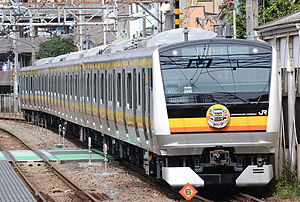Nambu Line
| Nambu Line | |||
|---|---|---|---|

A Nambu Line E233-8000 series EMU in October 2014
|
|||
| Overview | |||
| Native name | 南武線 | ||
| Type | Commuter rail | ||
| Locale | Tokyo, Kanagawa prefectures | ||
| Termini |
Kawasaki Tachikawa |
||
| Stations | 26 (main line), 3 (branch line) | ||
| Operation | |||
| Opened | 1927 | ||
| Owner | JR East | ||
| Rolling stock | 205 series, 209 series, E233-8000 series | ||
| Technical | |||
| Line length | 45.0 km (28.0 mi) | ||
| Track gauge | 1,067 mm (3 ft 6 in) | ||
| Electrification | 1,500 V DC overhead catenary | ||
|
|||
The Nambu Line (南武線 Nanbu-sen?) is a Japanese railway line which connects Tachikawa Station in Tachikawa, Tokyo and Kawasaki Station in Kawasaki, Kanagawa. For most of its length, it parallels the Tama River, the natural border between Tokyo and Kanagawa prefectures. It lies along the Tama Hills. It is part of the East Japan Railway Company (JR East) network. The line forms part of what JR East refers to as the "Tokyo Mega Loop" (東京メガループ?) around Tokyo, consisting of the Keiyo Line, Musashino Line, Nambu Line, and Yokohama Line. The name refers to the southern (南 nan?) part of the ancient province of Musashi (武蔵?) (now Tokyo and northern Kanagawa prefectures), through which the Nambu Line runs.
...
Wikipedia

